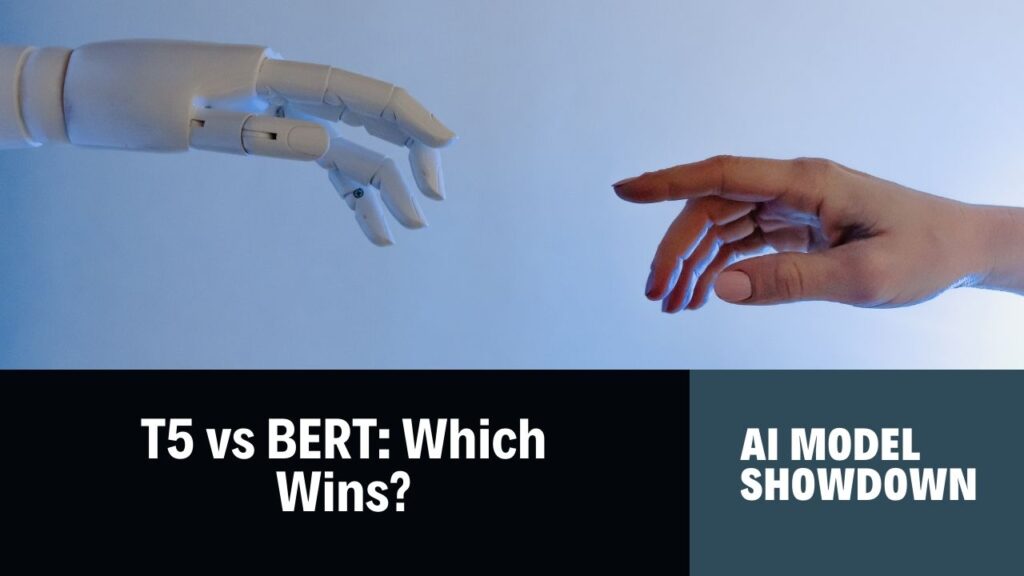
T5 model vs BERT are two popular models from Google in natural language processing. BERT is great for understanding sentence meaning, while T5 is more flexible, tackling tasks like translation and summarization. This guide will help you choose which model fits your needs better.
Table of Contents
ToggleWhat is T5 model
The T5 model (Text-to-Text Transfer Transformer) by Google converts all NLP tasks into a text format, like translation or summarization. It’s trained on a huge C4 dataset and can handle many tasks using the same method, making it versatile and powerful.
What is BERT Model
BERT (Bidirectional Encoder Representations from Transformers) is a language model developed by Google. It reads text in both directions (left to right and right to left) to understand the full context of a sentence. BERT is used for tasks like question answering, sentence classification, and text prediction. It’s known for improving performance in NLP tasks by better capturing the meaning of words in context.
What is the difference between BERT and T5 models?
T5 model vs Bert Chart Comparison
| Feature | BERT | T5 |
|---|---|---|
| Architecture | Encoder-only | Encoder-decoder |
| Training Objective | MLM and NSP | Unified text-to-text framework |
| Use Cases | Text classification, NER, QA | Translation, summarization, QA |
T5 model vs Bert Parameters
| Model | Parameters |
|---|---|
| T5-Small | 60 million |
| T5-Base | 220 million |
| T5-Large | 770 million |
| T5-3B | 3 billion |
| T5-11B | 11 billion |
| BERT-Base | 110 million |
| BERT-Large | 340 million |
T5 Model vs Bert Performances
- How it works: BERT reads the entire sentence from both directions to understand the context.
- Tasks: It predicts missing words and checks if one sentence follows another.
- Strengths: Great for understanding the meaning of sentences and performing tasks like answering questions and identifying entities.
T5 (Text-To-Text Transfer Transformer)
- How it works: T5 converts all tasks into a text-to-text format, meaning both input and output are text.
- Tasks: It can handle a variety of tasks like translation, summarization, and answering questions.
- Strengths: Very versatile and performs well across different tasks.
Comparison:
- Versatility: T5 is more versatile because it can handle many different tasks.
- Performance: Both are excellent, but T5 often has an edge in tasks that need generating text.
- Architecture: BERT is great for understanding context within a sentence, while T5 is better for tasks that require creating text.
| Feature | BERT | T5 |
|---|---|---|
| Architecture | Encoder-only, bidirectional | Encoder-decoder, text-to-text |
| Tasks | Predicts missing words, checks sentence order | Converts all tasks to text-to-text format |
| Strengths | Understanding sentence context | Versatility across different tasks |
| Performance | Excellent for understanding and classification | Excellent for generating and understanding |
| Versatility | Specialized for specific tasks | Handles a wide range of tasks |
Which is better?
- If you need a model for understanding and classifying text, BERT might be the better choice.
- If you require a model that can handle a variety of tasks and generate text, T5 would be more suitable.
In summary, both models are powerful, but their suitability depends on the specific tasks you have in mind. Choose BERT for context understanding and T5 for versatility and text generation.
People Also Ask Questions
Which is better, T5 or BART?
Both T5 and BART are powerful models with similar encoder-decoder architectures. T5 is more versatile due to its text-to-text framework, while BART excels in tasks like text summarization and generation. The choice depends on the specific task you have in mind.
What is better than BERT model?
Models like GPT-3 and T5 are often considered more advanced than BERT for certain tasks. GPT-3 excels in text generation, while T5 is highly versatile and can handle a wide range of NLP tasks.
What is the T5 model good for?
The T5 model is good for a variety of NLP tasks, including translation, summarization, question answering, and text classification. Its text-to-text framework makes it highly adaptable and powerful for different applications.